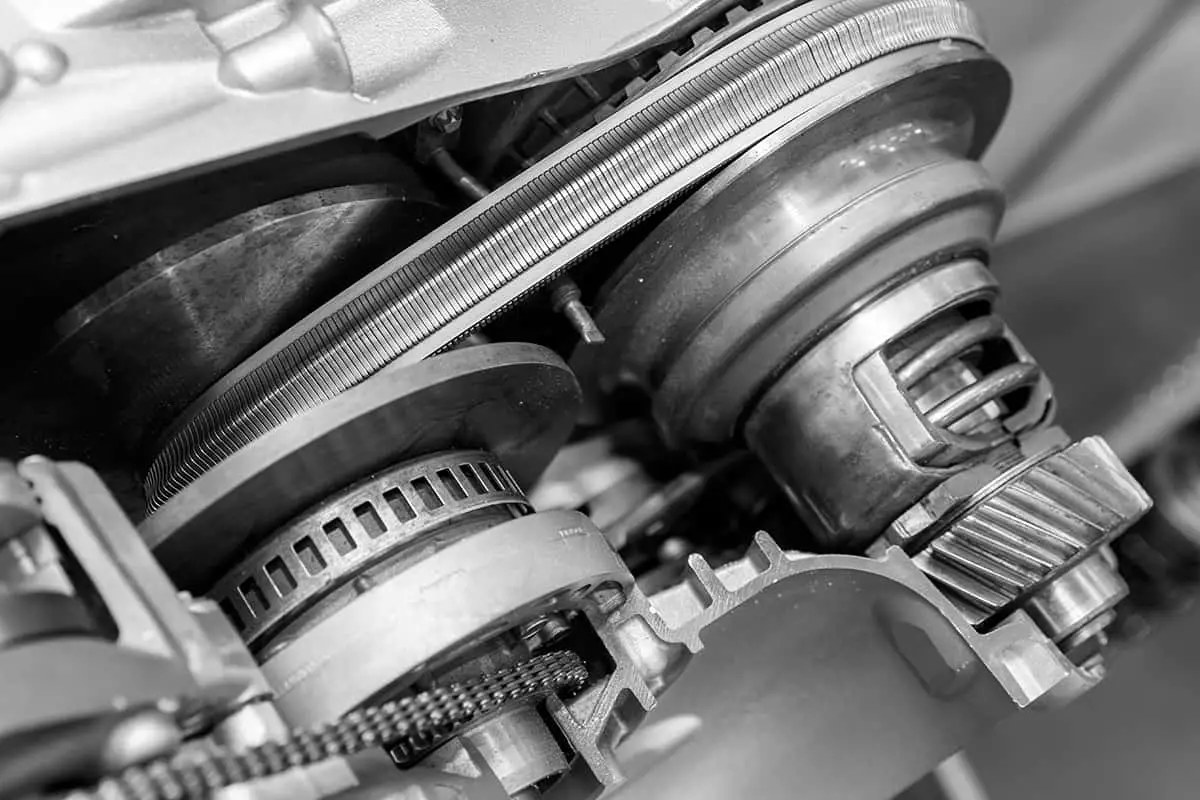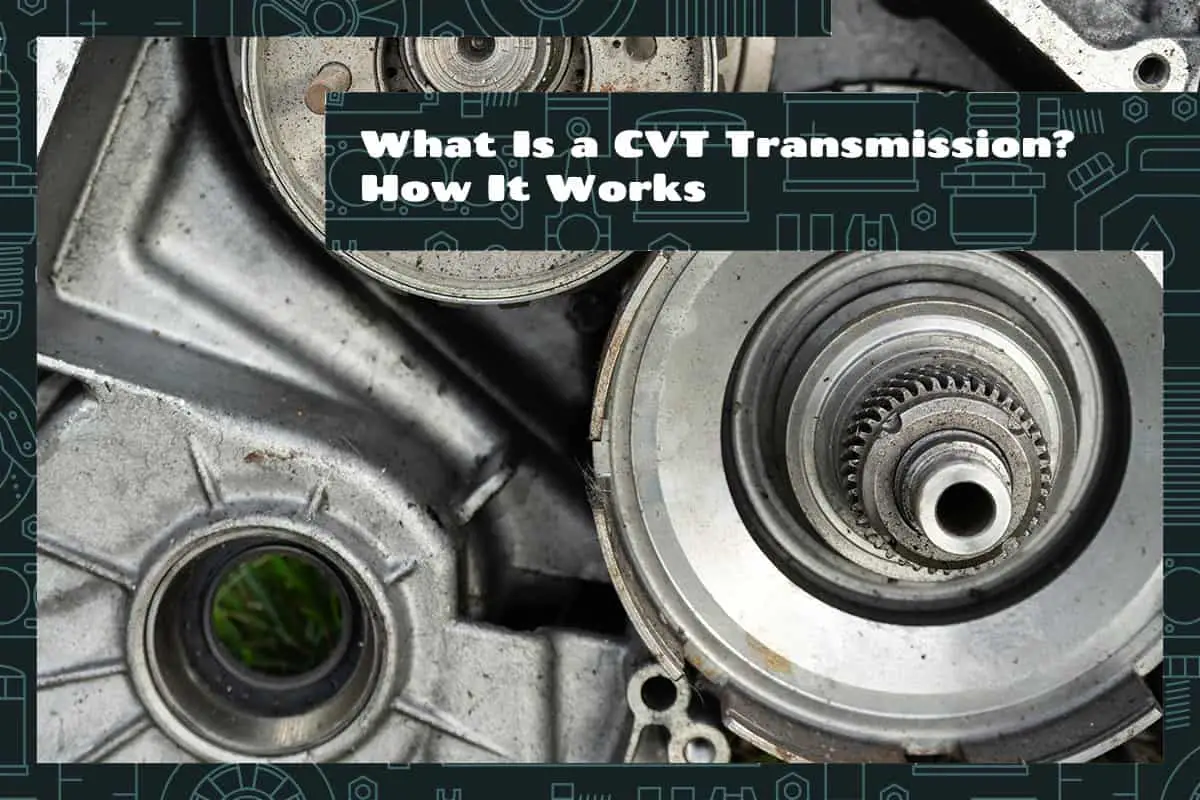Have you ever wondered how cars switch gears so smoothly while you’re driving? That’s the job of the transmission, a really important part of a car. There are different types of transmissions, but we’re going to focus on one special kind: the Continuously Variable Transmission, or CVT for short.
A CVT is a type of automatic transmission that uses two pulleys and a belt to change the engine’s gear ratios. Unlike traditional transmissions, it has no fixed number of gears. Instead, it can continuously change its gear ratio for optimal performance and fuel efficiency.
In this article, we’re going to take a deep dive into CVTs, exploring their parts and how they work.
Basic Overview of Car Transmissions
A car transmission, also known as a gearbox, is an integral part of the vehicle’s powertrain. It’s responsible for transferring the engine’s power to the wheels, allowing the car to move. The transmission controls the engine’s revolutions per minute (RPM), ensuring that the engine operates within an optimal range. It does this by shifting gears, which changes the ratio of engine speed to wheel speed.
The three most common types of transmissions in modern vehicles are manual transmissions, automatic transmissions, and CVTs. Each has distinct advantages and disadvantages.
Also known as stick shifts, manual transmissions give the driver direct control over gear selection. Drivers operate the clutch pedal and gear shift to manually change gears, making this type of transmission engaging but potentially difficult for beginners. Manual transmissions tend to be more fuel-efficient and durable but may be less convenient for stop-and-go city driving.
An automatic transmission shifts gears without any manual input from the driver, utilizing a complex system of fluid pressure, valves, and bands. It offers an easier and more relaxed driving experience, especially in heavy traffic. However, automatic transmissions are typically less fuel-efficient than manuals and can be more expensive to repair.
CVTs represent a different approach to the transmission design. Instead of fixed gears, a CVT uses a pair of variable-width pulleys connected by a belt to provide an infinite number of gear ratios. This unique design allows for smoother and more efficient driving, especially at low speeds. However, CVTs can feel different to drive and may have durability concerns under harsh driving conditions.
Core Components of a CVT Transmission
A CVT is made up of several key parts. These components work together to provide a smooth driving experience. Instead of using traditional gears like other transmissions, a CVT uses a clever system of pulleys and a belt. Let’s break down these parts and see how they all work together.
1. Primary Pulleys and Steel Belt
At the heart of a CVT are two pulleys connected by a steel belt. They’re designed to change their width depending on how much power the car needs. When the car needs to accelerate quickly, the pulleys adjust so the engine can run faster. When the car is cruising, the pulleys change again, so the engine doesn’t have to work as hard.
The steel belt connecting the pulleys is tough and flexible. It transmits the power from the engine to the wheels and adjusts as the pulleys change width. Unlike other transmissions that have a set number of gear ratios, a CVT can provide an infinite number of ratios because of this adjustable pulley system.
2. Hydraulic System
Another key component of a CVT is the hydraulic system. This system uses fluid to help control the width of the pulleys. When the car needs to change speed, the hydraulic system changes the fluid pressure, which causes the pulleys to adjust. The hydraulic system ensures that the pulleys can make these changes quickly and smoothly, so the car accelerates and decelerates without any jerky movements.
3. Electronic Control Unit (ECU)
The ECU is a computer that constantly monitors the car’s speed, load, and other factors. When the car needs to change speed, the ECU calculates the best ratio for the pulleys and commands the hydraulic system to adjust them. The ECU’s main goal is to keep the engine running as efficiently as possible, which can help save fuel and reduce wear and tear on the engine.
4. Torque Converter
The torque converter is another important part of a CVT. It’s responsible for transmitting the engine’s power to the transmission. When the car is at a standstill, the torque converter disconnects the engine from the transmission, so the engine can keep running without moving the car.
When the car starts moving, the torque converter smoothly reconnects the engine and the transmission, allowing the car to accelerate without any abrupt, jerky motion.
Working Principle of a CVT Transmission

Imagine your bike; you can only select a certain number of gears, right? A CVT, however, has an infinite number of gears, meaning it can find the best one for any situation.
Mechanical Components
At the heart of a CVT are two pulleys connected by a belt. One pulley, called the input pulley or drive pulley, is connected to the engine. The other, known as the output pulley or driven pulley, is linked to the wheels. Each pulley is made of two cone-shaped parts that can move together and apart, changing the diameter where the belt rides.
Operation of the CVT
Here’s a breakdown of how it works: as the engine speeds up, the drive pulley halves move together, making the belt ride higher and the pulley’s diameter larger. On the output pulley, the halves move apart, making the belt ride lower and the pulley’s diameter smaller. This changes the gear ratio. As the process is reversed, the gear ratio changes again, keeping the engine running at its most efficient speed.
Infinite Gear Ratios
In a traditional gearbox, you’d hear and feel the car shifting gears. With a CVT, it’s different. It can continuously adjust the gear ratio to best suit the driving conditions, keeping the engine at its most efficient or powerful speed. It’s like having a bike that always has the perfect gear available. This makes a CVT-equipped car smoother and often more fuel-efficient.
Advantages and Disadvantages of CVT Transmission
CVT has several pros and cons. Understanding them can help you decide if a car with this type of automatic transmission is right for you.
Advantages of CVT Transmission
1. Fuel Efficiency
Because a CVT can always adjust to match the engine’s optimal speed, it can keep the engine in its most fuel-efficient range, reducing the amount of gas the car uses and saving you money at the pump.
2. Smooth Operation
Traditional transmissions have a set number of gears, and you can feel a jolt each time the car changes from one gear to another. But a CVT can change between an infinite number of gear ratios without any sudden jumps, providing a smoother ride.
3. Simplified Driving
With a CVT, driving is simpler because there are no gears to manually change. This feature is especially useful for new drivers or those who prefer not to manually shift gears. The transmission does all the work for you, keeping the focus on the road.
Disadvantages of CVT Transmission
1. Repair Costs
On the flip side, CVTs can be costly to repair or replace. This is because they’re more complex than regular transmissions.
2. Lack of Driving Enjoyment
Some drivers find CVTs less enjoyable to drive. Unlike a manual transmission, where you can control the gears, a CVT does the work for you. Some drivers miss the feel of shifting gears, which can make driving more engaging.
3. Noise
CVTs can also produce a continuous noise that can be unsettling to some. Because a CVT doesn’t have set gear ratios, the engine noise can seem constant and drone-like, which some drivers find annoying.






